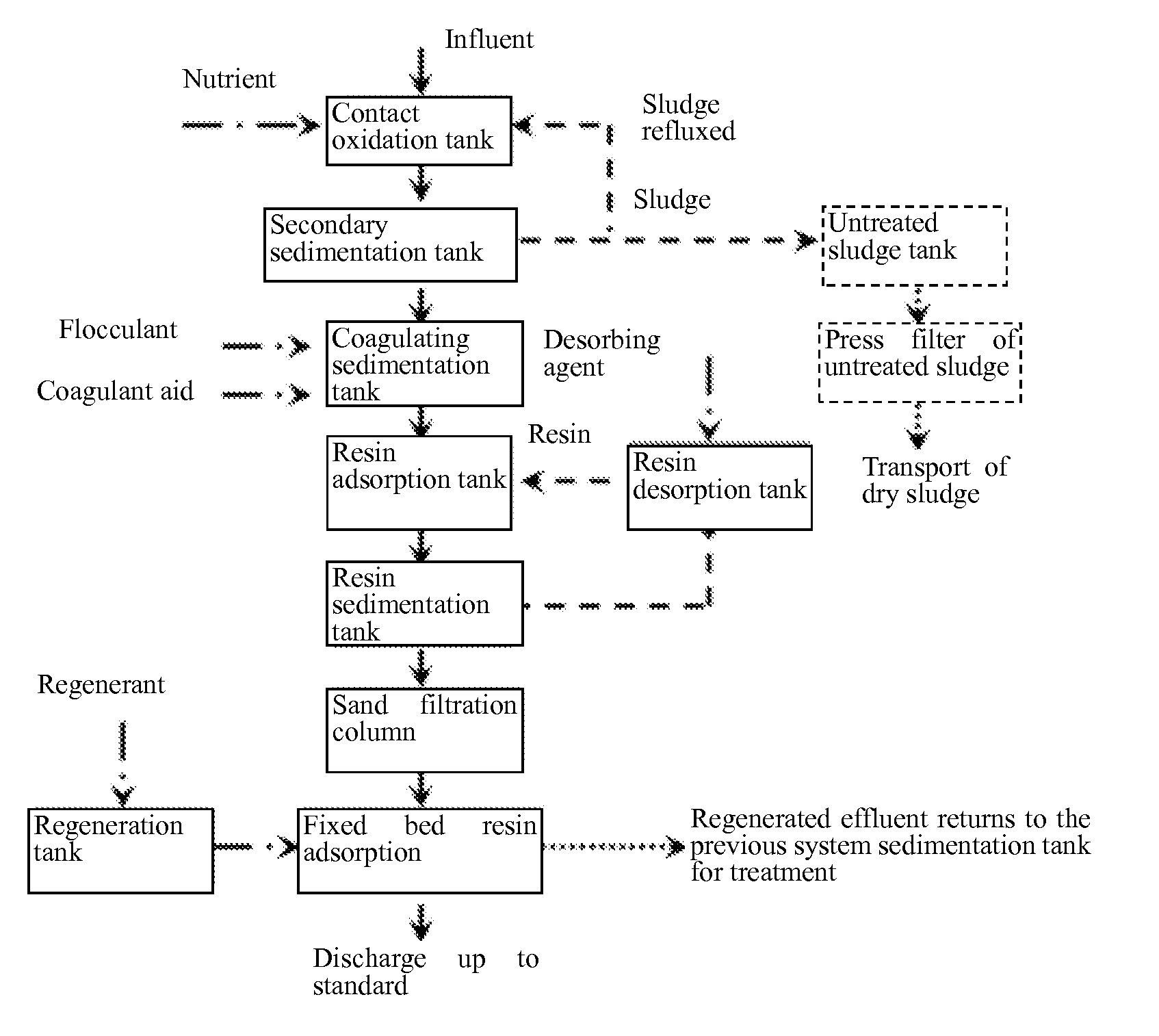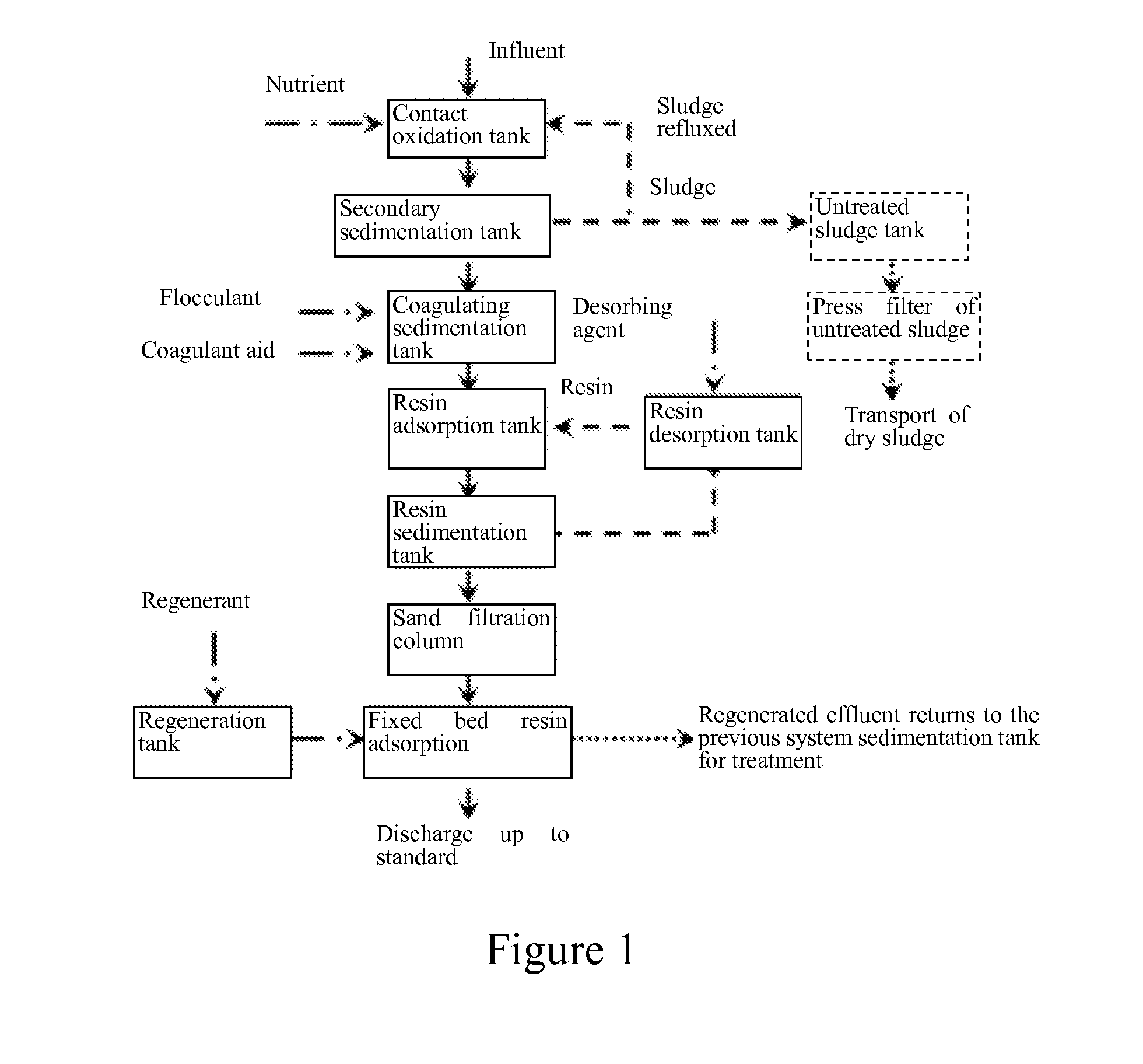Efficient combined advanced treatment method of electroplating waste water
a wastewater and advanced treatment technology, applied in water/sewage multi-stage treatment, water/sewage treatment by ion exchange, sustainable biological treatment, etc., can solve the problems of heavy pollution, complex composition of wastewater therefrom, and inability to meet discharge standards, etc., to achieve low treatment cost, high compatibility with wastewater, and good economic performan
- Summary
- Abstract
- Description
- Claims
- Application Information
AI Technical Summary
Benefits of technology
Problems solved by technology
Method used
Image
Examples
example 1
[0026]In this example, electroplating wastewater of a workshop after pretreatments including cyanide breaking, dechromisation and coagulating sedimentation, was treated. The water quality of the effluent after pretreatments is shown in Table 1. The treatment steps were as follows.
[0027](1) Bio-contact oxidation: An influent at a pH of 7.0 and at a temperature of 15° C. was introduced to a 100 L bio-contact oxidation tank at a rate of 10 L / h. Glucose was added to adjust the BOD / COD to 0.3. The dissolved oxygen (DO) was maintained at 3.5 mg / L by intermittent aeration with an aerator, and the hydraulic retention time was 10 h. The sludge generated in the contact oxidation tank was filter-pressed by a plate and frame filter press, and then the dry sludge was transported for treatment.
[0028](2) Coagulating sedimentation: The effluent from the step (1) was charged to a coagulating sedimentation tank. A polyferric flocculant polyferric sulfate (PFS) was used in an amount 1% by volume of th...
example 2
[0031]In this example, electroplating wastewater of an electronic industrial park after pretreatments including cyanide breaking, dechromisation and coagulating sedimentation, was used as the effluent to be treated. Comprehensive wastewater after pretreatments was introduced to a bio-contact oxidation tank at a pH of 8 and at a temperature of 30° C. at a rate of 100 t / d. Glucose was manually added as a nutrient source to control the BOD / COD to 0.4. The dissolved oxygen (DO) content was maintained at 5 mg / L by intermittent aeration, and the hydraulic retention time was 8 h. The effluent from the contact oxidation tank was precipitated in an inclined pipe of a secondary sedimentation tank to realize the separation of sludge from water. The effluent was charged to a coagulating sedimentation tank. A polyaluminum flocculant polyaluminium chloride (PAC) was added in an amount of 1‰ by volume of the wastewater to be treated. Polyacrylamide (PAM) was added as the coagulant aid in an amount...
example 3
[0032]The treatment method in this example was substantially the same as that in Example 1, except that in the step (1), the influent of the contact oxidation tank was at a pH of 6.5 and at a temperature of 25° C., an aerator was used for intermittent aeration, and the dissolved oxygen (DO) content was maintained at 2 mg / L; in the step (2), a polyferric flocculant polyferric sulfate (PFS) and a poly aluminum flocculant polyaluminium chloride (PAC) were added both in an amount of 1‰ by volume of the wastewater to be treated; in the step (3), the amount the magnetic resin was 1‰ by volume of the wastewater to be treated; and in the step (4), the resin was the N,N-bis-(carboxymethyl) disubstituted dithiocarbamate chelating resin developed by Nanjing University as disclosed in Chinese Patent No. CN100560617C granted on Nov. 18, 2009. The water quality of the effluent was substantially the same as that in Table 1.
[0033]The process of “bio-contact oxidation—coagulating sedimentation—magne...
PUM
| Property | Measurement | Unit |
|---|---|---|
| concentration | aaaaa | aaaaa |
| concentration | aaaaa | aaaaa |
| BOD/COD | aaaaa | aaaaa |
Abstract
Description
Claims
Application Information
 Login to View More
Login to View More - R&D
- Intellectual Property
- Life Sciences
- Materials
- Tech Scout
- Unparalleled Data Quality
- Higher Quality Content
- 60% Fewer Hallucinations
Browse by: Latest US Patents, China's latest patents, Technical Efficacy Thesaurus, Application Domain, Technology Topic, Popular Technical Reports.
© 2025 PatSnap. All rights reserved.Legal|Privacy policy|Modern Slavery Act Transparency Statement|Sitemap|About US| Contact US: help@patsnap.com


